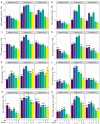Role of Acetic Acid and Nitric Oxide against Salinity and Lithium Stress in Canola (Brassica napus L.)
- PMID: 38202358
- PMCID: PMC10781170
- DOI: 10.3390/plants13010051
Role of Acetic Acid and Nitric Oxide against Salinity and Lithium Stress in Canola (Brassica napus L.)
Abstract
In this study, canola (Brassica napus L.) seedlings were treated with individual and combined salinity and lithium (Li) stress, with and without acetic acid (AA) or nitric acid (NO), to investigate their possible roles against these stresses. Salinity intensified Li-induced damage, and the principal component analysis revealed that this was primarily driven by increased oxidative stress, deregulation of sodium and potassium accumulation, and an imbalance in tissue water content. However, pretreatment with AA and NO prompted growth, re-established sodium and potassium homeostasis, and enhanced the defense system against oxidative and nitrosative damage by triggering the antioxidant capacity. Combined stress negatively impacted phenylalanine ammonia lyase activity, affecting flavonoids, carotenoids, and anthocyanin levels, which were then restored in canola plants primed with AA and NO. Additionally, AA and NO helped to maintain osmotic balance by increasing trehalose and proline levels and upregulating signaling molecules such as hydrogen sulfide, γ-aminobutyric acid, and salicylic acid. Both AA and NO improved Li detoxification by increasing phytochelatins and metallothioneins, and reducing glutathione contents. Comparatively, AA exerted more effective protection against the detrimental effects of combined stress than NO. Our findings offer novel perspectives on the impacts of combining salt and Li stress.
Keywords: antioxidant system; combined stress; exogenous chemicals; heavy metal stress; plant growth; salt stress.
Conflict of interest statement
The authors have no conflicts of interest to disclose.
Figures








Similar articles
-
Lipoic Acid Combined with Melatonin Mitigates Oxidative Stress and Promotes Root Formation and Growth in Salt-Stressed Canola Seedlings (Brassica napus L.).Molecules. 2021 May 25;26(11):3147. doi: 10.3390/molecules26113147. Molecules. 2021. PMID: 34070241 Free PMC article.
-
Nitric oxide, calmodulin and calcium protein kinase interactions in the response of Brassica napus to salinity stress.Plant Biol (Stuttg). 2023 Apr;25(3):411-419. doi: 10.1111/plb.13511. Epub 2023 Mar 11. Plant Biol (Stuttg). 2023. PMID: 36779525
-
A study of proline metabolism in canola (Brassica napus L.) seedlings under salt stress.Molecules. 2012 May 16;17(5):5803-15. doi: 10.3390/molecules17055803. Molecules. 2012. PMID: 22592086 Free PMC article.
-
Proteomic and biochemical responses of canola (Brassica napus L.) exposed to salinity stress and exogenous lipoic acid.J Plant Physiol. 2015 May 1;179:90-9. doi: 10.1016/j.jplph.2015.03.006. Epub 2015 Mar 20. J Plant Physiol. 2015. PMID: 25841209
-
Emerging warriors against salinity in plants: Nitric oxide and hydrogen sulphide.Physiol Plant. 2021 Apr;171(4):896-908. doi: 10.1111/ppl.13380. Physiol Plant. 2021. PMID: 33665834 Review.
Cited by
-
Effect of polyamine precursors and antioxidants on growth and metabolism of salt-stressed barley.F1000Res. 2024 Jan 18;12:262. doi: 10.12688/f1000research.130979.2. eCollection 2023. F1000Res. 2024. PMID: 39479231 Free PMC article.
-
Antioxidant Responses in Chromium-Stressed Maize as Influenced by Foliar and Root Applications of Fulvic Acid.Sci Rep. 2025 Jan 8;15(1):1289. doi: 10.1038/s41598-024-84803-4. Sci Rep. 2025. PMID: 39779785 Free PMC article.
References
-
- FAO . Global Map of Salt-Affected Soils 2021. FAO; Rome, Italy: 2021.
-
- Shabbir R., Singhal R.K., Mishra U.N., Chauhan J., Javed T., Hussain S., Kumar S., Anuragi H., Lal D., Chen P. Combined Abiotic Stresses: Challenges and Potential for Crop Improvement. Agronomy. 2022;12:2795. doi: 10.3390/agronomy12112795. - DOI
-
- Hoque T.S., Sohag A.A.M., Kordrostami M., Hossain M.A., Islam M.S., Burritt D.J., Hossain M.A. The Effect of Exposure to a Combination of Stressors on Rice Productivity and Grain Yields. In: Roychoudhury A., editor. Rice Research for Quality Improvement: Genomics and Genetic Engineering: Volume 1: Breeding Techniques and Abiotic Stress Tolerance. Springer; Singapore: 2020. pp. 675–727.
LinkOut - more resources
Full Text Sources

